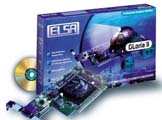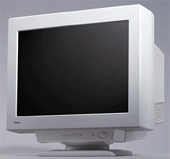High-end Professional
A high-end professional
system requires a number of high-end components. CPU performance is critical
and we need more RAM here than any other system we've looked at previously.
The graphics requirements are also very different in the professional space
and a large monitor is critical.
 CPU
– AMD Athlon 850 - $750
CPU
– AMD Athlon 850 - $750
The Athlon performs
extremely well under professional applications, especially when teamed with
the KX133 chipset. Right now, the 850 is the fastest widely available Athlon,
and it’s very reasonably priced at $750. Trying to find a Pentium III faster
than 800 MHz is extremely difficult, and you’ll have to pay quite a bit to get
it.
If an SMP system would benefit your applications significantly, look for an i840 board with SDRAM support. RDRAM is simply too expensive right now, while the i440BX and its PC100 memory interface struggles with our test suite of professional apps.
For more information on all Athlon processors, read our Athlon 1GHz Review.
Motherboard – EPoX EP-7KXA
- $140
If you’re going
with an Athlon CPU, the VIA KX133 chipset is clearly the best platform to run
it on. Unfortunately, there’s a lack of good KX133 boards that are also widely
available and that has driven price up considerably through good old supply
and demand. The EPoX is the only widely available KX133, so it’s our pick for
now, but better KX133 boards are on the way.
For more information, read our EPoX EP-7KXA Review.
Memory – 512MB Corsair
or Mushkin PC133 SDRAM (2x256MB DIMM’s) – $600
Even though memory
is relatively cheap these days, it is a key factor in the performance of most
professional apps. For a high-end system like this, 512MB is not unreasonable
and easily fits within the budget.
As for the exact brand of memory, we recommend Corsair or Mushkin modules. We use them in our test systems and have had absolutely no problems with them.
 Video
Card – ELSA GLoria II (NVIDIA Quadro) - $650
Video
Card – ELSA GLoria II (NVIDIA Quadro) - $650
NVIDIA’s Quadro
is simply the most powerful workstation 3D accelerator we’ve tested to date.
Based on the same T&L GPU of the GeForce, the Quadro runs at a higher core
clock speed, 135 MHz, and enables certain features that were left disabled on
the GeForce. Among these features is enhanced support for anti-aliased points
and lines, which, although it isn’t a commonly used feature with most users,
was an extremely poor performance point for the GeForce.
With their previous experience in the professional market, ELSA was able to score exclusive rights to manufacture the Quadro. The GLoria II is ELSA’s implementation and comes with 64MB SDR SDRAM. While a DDR version of the Quadro has been announced, and even tested by AnandTech, it’s not actually available anywhere at the moment. At $650, the SDR version of the GLoria II is a relative steal compared to some of the other professional 3D accelerators out there. Throw in the fact that it’s fully support under Windows NT 4.0, Windows 2000, and Linux and it becomes quite clear that the Quadro is the best choice.
For more information, see our ELSA Gloria II Review.
 Monitor
– iiYama VisionMaster PRO 510 - $1000
Monitor
– iiYama VisionMaster PRO 510 - $1000
Using a Mitsubishi
Diamondtron NF, the iiYama VisionMaster Pro 510 provides a perfectly flat display
surface using the same technology in Sony’s FD Trinitron models, but at a lower
cost. Make sure you can deal with the damper wires that all Trinitron style
tubes have. The VisionMaster PRO 510 is a 22” monitor and has been highly acclaimed
here on AnandTech and by owners alike.
For more information, read our iiYama VisionMaster PRO 450 and VisionMaster PRO 510 Reviews.










0 Comments
View All Comments